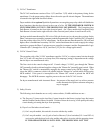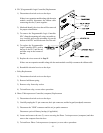
86
b. PLC (Programmable Logic Controller)
1) The PLC (Programmable Logic Controller) can consist of one (1) or two (2) modules; a main module
and in some cases an expansion module is used for additional inputs and outputs.
NOTE: The information listed below is generic in nature, refer to blueprints for specific details.
a) The main PLC (Programmable Logic Controller) module has eight (8) input relays which are
labeled #0 through #7 and six (6) output relays labeled #200 through #205.
(1) Input Relays
Input relays #0, #1, #2, and #3 are set up as users inputs to signal what specific function is to
be performed (i.e., open-close door, load-unload tilted, open doors, and level dryer). These
input relays are charted as 1 and 0 (
1 is logic on and 0 is logic off). When either an input
relay or an output relay in on, the appropriate L.E.D. (light emitting diode) on the PLC will be
illuminated.
For input relay #4 to turn on, the left and right front doors must be completely open. Once
these doors are completely open, the jog forward (input #5) and jog reverse (input #6) can turn
on through the PLC (Programmable Logic Controller) which in turn rotates the tumbler (drum
and basket) through either output relay #204 or output relay #205 providing the lint door is
closed. This interlock is performed through PLC input #16 (lint door closed), or in some cases
contactor B is used to interrupt the 24 VAC signal from reaching the drive contactors and the
tilting solenoids.
(2) Output Relays
Output relay #200 controls the open front door function. When this signal is energized, the
pneumatic valve opens allowing air into the two (2) door cable cylinders, which in turn opens
the front doors.
The end of cycle (EOC) output (relay #202) switches on after an air jet signal is received.
This output relay will stay illuminated until the dryer is attended to.
During a drying cycle, the PLC (Programmable Logic Controller) monitors the status of the
Phase 5 microprocessor controller (computer) "HEAT ON/OFF" signal. Input relay #13 is the
"control status" of the front and rear gas valves and monitors the state of both the front burner
and rear burner "Air Flow" switches. If a fault is sensed, input #13 L.E.D. (light emitting
diode) turns off at that point and output relay #203 "HEATER FAULT" indicator and output
relay #202 "END OF CYCLE" indicator will begin to flash at a rate of one (1) flash per
second. Both indicators will flash until the operator presses the "HEATER FAULT" indicator/
reset push-button.
Output relay #204 (drive forward) and output relay #205 (drive reverse) are used to perform
jog functions.


















